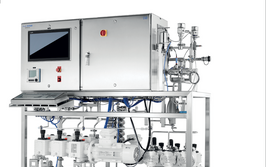Raising Respiratory Awareness
Respiratory drug development lags behind other therapeutic areas, but why? And what new advances could help shape the future?
Great strides have been made in medicine as of late, with the recent approval of Kymriah – the first CAR-T therapy – being heralded as a breakthrough. Certainly, the cancer field is seeing a number of exciting drug development projects, but other fields are being left behind. The field of respiratory medicine, in particular, is plagued by unmet needs. First of all, there is very little awareness of respiratory disease at all. For chronic obstructive pulmonary disease (COPD), for instance, diagnosis rates can be as low as 30 percent (1)(2) resulting in unnecessary delays in treatment initiation. Even when a patient is correctly diagnosed, treatment is often less than ideal. Moreover, there are clearly unmet needs in the treatment of COPD, such as exacerbation and symptom control, improving health status, and slowing the decline of lung function and disease progression (3). Although there is considerable evidence that bronchodilators provide lung function improvements, as well as clinical benefits in patients with COPD, inhalable drugs often cause compliance issues due to the difficulty of correctly administering pulmonary or nasal formulations – research has estimated that only 1 out of 10 patients with a metered dose inhaler performs all of the steps correctly (4).
Patients with respiratory diseases need new medicines that alleviate symptoms and modify the course of the disease without, at the same time, causing undue side effects and/or non-adherence to medication regimens. In 2015, COPD alone caused 3 million deaths – accounting for 5 percent of all deaths globally (5) – but despite this there are few treatments being investigated in industry pipelines. Many other respiratory conditions are also being neglected, including orphan diseases such as cystic fibrosis, idiopathic pulmonary fibrosis (IPF) and pulmonary arterial hypertension (PAH). Non-inhaled drugs, particularly oral or sublingual formulations, are expected to be particularly welcome from a compliance perspective.

Rising to the challenges
Many believe that respiratory medicine is a stagnating field (6), which is unacceptable given that the incidence of respiratory disease is rising with air pollution and reduced birth rates (the elderly are far more prone to respiratory disease). Researchers and the industry have significant work to do, but the question is where do we start?
Rising costs of drug development affect all therapeutic areas, but in respiratory medicine the economic difficulties are exacerbated by high attrition rates and chronic underfunding. Respiratory drug development is difficult and the lack of available treatments can perhaps be partly attributed to a shortage of critical tools in the areas of biomarkers and clinical outcome measures. Hence, advances in precision medicine and targeted treatments seen in fields such as oncology simply have not been reflected in the respiratory field. Notably, in terms of measuring patient-relevant outcomes in respiratory drug trials, investigators currently rely on classical, subjective evaluation methods; in particular, forced expiratory volume over one second (FEV1) and forced vital capacity (FVC). These outcome measures remain standard, yet often show poor correlation with patient-relevant outcomes, such as quality of life and mortality – and therefore are of limited use. When managing chronic diseases such as asthma, tools that permit the prediction of functional decline are essential – methods that merely plot deterioration over time can only get you so far.
So where might new tools come from? This question points to another problem: the paucity of molecular targets to guide the development of respiratory biomarkers and drugs. Oncology is rich in targets that suggest new drug-biomarker possibilities. A shortage of biomarkers in respiratory medicine – including both laboratory tools and clinically validated biomarkers recognized by regulatory authorities – makes monitoring and assessing patients difficult. And without a biomarker to use as a surrogate endpoint, clinical studies are rendered far more difficult, so it’s no wonder there is a lack of advanced drugs in the respiratory field. Regulatory requirements are notoriously strict and many of today’s tools just do not offer the required accuracy.
That said, there have been some promising – albeit small – success stories in recent years. At the level of basic research, there have been advances in the understanding of the aetiological role of cystic fibrosis transmembrane conductance regulator (CFTR) gene mutations. This knowledge has been translated into two marketed products: Vertex’s Kalydeco (ivacaftor) – the early development of which was funded by the Cystic Fibrosis Foundation – and the combination product Orkambi (lumacaftor/ivacaftor). These are now helping at least the small proportion of patients who have the CFTR mutation targeted by these drugs. Cost, however, is an issue; in the UK, for instance, Orkambi is considered too expensive by the country’s cost watchdog NICE (The National Institute for Health and Care Excellence). Additional drugs currently in pipelines will, hopefully, address other CTFR mutant genotypes in the future.
On a clinical level, developments in monoclonal antibody therapeutics are particularly promising, notably for treating inflammatory diseases by targeting immunoglobulin E and cytokines such as interleukins (IL) 4, 5 and 13. One example is the IL-5 targeting antibody Nucala (mepolizumab) from GlaxoSmithKline, which is licensed to treat severe asthma. Investigative products in this field include Medimmune’s IL-5 antibody benralizumab, and Regeneron’s IL4/13 antibody depilumab – these treatments have shown real promise and could signal a positive shift in the treatment of COPD and asthma. Similarly, in the field of anti-fibrotics for IPF, encouraging progress is evident: Boehringer Ingelheim’s Ofev (nintedanib), and Intermune’s Esbriet (pirfenidone) recently reached the market, and the IPF development pipeline includes some very exciting drugs, not least stem cell therapies. Finally, of course, lung cancer therapies move apace, both with regard to recent approvals and to drugs in the pipeline.
Changing times
These advances are a good start to a new tide of innovation in respiratory development, but progress would be significantly faster if researchers and industry had access to advanced biomarkers and better methods of measuring and predicting outcomes. That said, some changes are evident in the field: for example, measurement of fractional exhaled nitric oxide (FeNO) is increasingly used as an outcome in respiratory clinical trials, as it is considered to be an easy way to measure inflammation. Also, plasma fibrinogen was recently (September 2016) accepted by the FDA as a biomarker for studies examining exacerbations in COPD; however, it has not been broadly taken up in the clinician community. In the research arena, eosinophil levels in sputum and blood are commonly used as a marker and also as a selection criterion; initially, this method was mainly used to measure outcomes after treatment with inhaled corticosteroids, but it is now often used to assess the effect of anti-inflammatory monoclonal antibodies. Similarly, interleukins, such as IL6, may hold promise as outcome parameters in inflammatory disease; as yet, however, these have not been formally validated, let alone recognized by regulatory authorities. At an earlier stage still, periostin, which binds to certain integrins, is showing promise as an inflammation indicator inTH2-mediated asthma. Similarly, copeptin – which is the C-terminal fragment of provasopressin, and thus a surrogate marker for vasopressin – has potential as a biomarker for cardiovascular risk. Since cardiovascular risk is increased in COPD and other inflammatory diseases, elevated copeptin levels may be relevant in the respiratory field.
There is also more reason for optimism in the field of outcomes measurement in respiratory medicine. Forced oscillation technique (FOT) is a new method that is increasingly used in clinical trials of respiratory therapies. This non-invasive technique measures the mechanical properties of the respiratory system across a wide range of frequencies. In addition, unlike spirometric techniques, it does not require active patient participation. Another advantage of FOT is that it makes measurements at the small airway level, which enables it to provide a better picture of disease progression than methods that rely on measurements from the large airways. Quantified imaging techniques also hold great promise, although none have yet been approved by regulators. One such technique is functional respiratory imaging, which creates 3D segmented computer models of the lungs using techniques such as computed tomography, magnetic resonance imaging and ultrasound. Subjecting these models to analytical methodologies derived from the aerospace industry – in particular, computational fluid dynamics and finite element analysis – provides invaluable information on pulmonary function and post-inhalation distribution of drug particles.
On the data side, the introduction of electronic clinical outcome assessments (ECOAs) is also having an impact on respiratory drug development. In ECOA, outcomes data from electronic patient records are integrated with lung function measurements, using a single device; these data are linked to a server by a safe internet connection, thus enabling data to be collected at the patient’s home and made immediately available for analysis. While not unique to the respiratory area, this innovation could have a significant impact by demonstrating whether a drug is providing sufficient benefit.
An improved understanding of inflammatory mechanisms is likely to lead to identification of respiratory disease-specific targets, which in turn could lead to the investigation of new treatment modalities, hopefully within the next four or five years. Genetic therapies, too, may finally live up to their initial promise – albeit in the slightly longer term – particularly in cystic fibrosis and pulmonary arterial hypertension. In the near term, however, there is hope that -omics analysis will lead to new diagnostic tools, biomarkers and outcome measures. With luck, these could offer real benefits to respiratory disease patients in the coming years – and lead to a new boom in respiratory drug development.
Robert Lins is SGS’s Clinical Research, Respiratory Project Director.
- DM Mannino et al., “Obstructive lung disease and low lung function in adults in the United States: data from the National Health and Nutrition Examination Survey, 1988–1994”, Arch. Intern. Med., 160, 1683-1689 (2000). PMID:10847262
- E Laura et al., “Undiagnosed Chronic Obstructive Pulmonary Disease Contributes to the Burden of Health Care Use. Data from the CanCOLD Study”, Am. J. Respir. Crit. Care Med., 194, 285-298 (2016). PMID: 26836958
- F Patalano et al., “Addressing unmet needs in the treatment of COPD”, Eur. Respir. Rev., 23, 333-344 (2014). PMID: 25176969
- RD Restrepo et al., “Medication adherence issues in patients treated for COPD”, 3, 371-384 (2008).
- WHO, “Chronic obstructive pulmonary disease (COPD)” (2016). Available at: bit.ly/1nytnII. Last accessed: October 12, 2017.
- ID Pavord et al., “After asthma: redefining airways diseases”, The Lancet (September 2017).
Robert Lins is SGS’s Clinical Research, Respiratory Project Director.


















